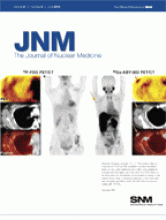TO THE EDITOR: With interest we read the recent publication of Scheuermann et al. (1), who reported on the experience of the American College of Radiology Imaging Network in qualifying PET scanners to participate in multicenter trials. The network does so by analyzing submitted PET scans of uniform cylinders (either solid 68Ge or fillable with 18F) to verify the accuracy of scanner calibration (in terms of standardized uptake values) and by qualitatively reviewing typical patient images. Because many of the sites tested have been unable to produce acceptable results on the first attempt, the authors concluded that a verification of the basic scanner calibration is extremely important before sites can be allowed to participate in multicenter trials.
From our experience (2), we fully support this final conclusion. In particular, we agree that testing with fillable phantoms provides an independent check of system calibration and is a useful metric in characterizing the operator's experience in measuring and recording the injected dose accurately. The problems encountered are likely to occur in clinical acquisitions, too. The authors claim that using an identical phantom for calibration or normalization and for standardized uptake value testing, that is, a 68Ge cylinder, may propagate errors. This claim is reflected in our findings, also. In our opinion, using the same phantom for calibration and verification is in some way a circular argument and may even completely hide calibration errors.
In the qualification process for PET scanners used in German multicenter trials, a somewhat different approach is followed (2), emphasizing testing of all equipment involved in the final analysis chain. Basically, each scanner is calibrated in terms of activity concentration, which is rescaled to standardized uptake values by normalization to the ratio of injected activity to body volume (approximated by patient weight). Therefore, careful cross calibration between PET scanner and dose calibrator is essential (2,3). The verification chain therefore starts with the dose calibrator, whose accuracy is checked by certified 68Ge sources. This test not only verified the instrument itself but also facilitated the identification of errors in the subsequent chain. The PET scanner calibration and processing is then tested through measurement of a cylindric phantom filled with a known activity concentration of 18F solution, relying on the accuracy of the calibrator. Data were acquired to a high statistical quality to facilitate the detection of systematic errors during subsequent analysis of reconstructed images.
In the beginning, the fraction of instruments failing on a first attempt was quite similar to the data reported, but there was an improvement for subsequent qualification processes associated with participation in further multicenter trials, an effect attributable to training and increasing experience.
Footnotes
-
COPYRIGHT © 2010 by the Society of Nuclear Medicine, Inc.







